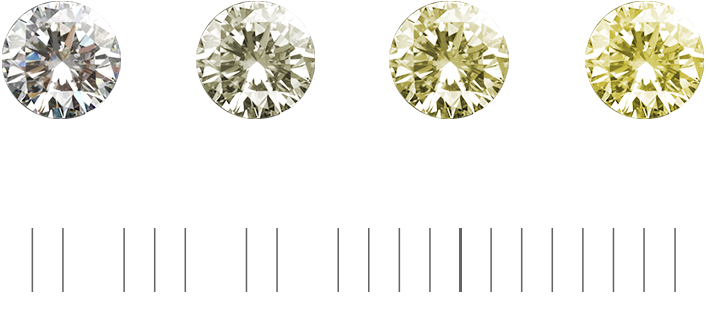The 4 Cs OF Diamonds
Understanding Cut: A diamond cut is a style or design guide used when shaping a diamond for polishing. Cut does not refer to the shape of a stone (pear, oval etc.), but rather the symmetry, parameters and polishing quality of the diamond. The cut of a diamond greatly impacts your diamond’s look and associated shimmer suggesting that the better the cut quality of your diamond, the more luminous it will appear to the naked eye.
What This Means for a Buyer: When admiring a diamond, a novel eye is less likely to catch the quality of the diamond’s cut. Therefore, one should look closely at the shimmer and shine of the stone to judge the quality of its cut. Simply put, select the diamond that looks most appealing face up to the naked eye.

Understanding Clarity: Clarity, sometimes referred to as purity, is a combination of how many inclusions occur within a diamond, their overall positioning and their visual prevalence on the stone’s overall look. These inclusions are what distinguish a diamond from every other diamond. While grading a diamond’s clarity, the following qualities are considered:
- Size - How small or large is the inclusion?
- Position - Where in the stone is the inclusion?
- Color - How light or dark is the inclusion?
- Number - How many inclusions are there in the diamond?
- Relief - How thick or thin is the inclusion?
- Nature - What type of inclusion is it?
What This Means for a Buyer: Typically, when a buyer’s budget is fixed, the major two variables to consider are size (carat) and clarity. If one seeks to purchase a larger stone with a fixed budget in mind, he/she will naturally seek a stone with a weaker purity to compensate for the increase in size.

Understanding Carat: A carat is a unit of measurement used to weigh a diamond. One carat is equal to 200 milligrams, or 0.2 grams. Considering the relatively small size of diamonds, the broader diamond community very early on developed an industry standard to measure the weight of a diamond; that is, the carat.
Diamond weights are measured with the accuracy of a thousandth of a carat (.000) but are given a weight that is rounded to the nearest hundredth. For example, 1.23 carats would be expressed as 'one carat and twenty three points.' A diamond weighing less than one carat is also represented as a decimal, such as 0.72, in which case it would be said to weigh seventy two points.
What This Means for a Buyer: Though the subject of carat weight is fairly straightforward, it is important to understand how the weight of a diamond affects its price. As a stone gets larger in size (keeping color, clarity and cut constant), it naturally comes with a higher price tag. However, the major price discrepancies on the most minor differences in carat weight are readily seen on incremental weight changes.
For example, a stone weighing 1.50 carats will carry a significant premium to a stone weighing 1.48 carats whereas the price of two stones weighing 1.42 carats and 1.46 carats respectively will largely be the same (holding all else constant).
Understanding Color: Natural diamonds, typically white and colorless, are categorized on a D – Z scale (D is colorless and the most white). However, natural diamonds can also host a variety of colors — steel gray, white, blue, yellow, orange, red, green, pink, purple, brown, black, and virtually any other color on the color spectrum. Naturally colored diamonds contain interstitial impurities or structural defects that cause the coloration, whilst pure diamonds are perfectly transparent and colorless.
What This Means for a Buyer: Though it is not readily apparent to an untrained eye, color is important to understand as it can cause one of the largest swings to the price of a diamond. On white diamonds (D-Z), the higher the color grade, the more colorless (and therefore more valuable) a diamond becomes. On fancy colored diamonds, their exclusivity and rarity alone demands a price premium Brownish, grayish and yellowish tinges can reduce the price of a diamond.
s











